Abstract
Background: Hyperthyroidism is associated with atrial fibrillation (AF), and the latter is a major risk factor for stroke. Aim: We aimed to investigate the yearly incidence of stroke and bleeding in AF patients with and without concomitant hyperthyroidism from the French National Hospital Discharge Database. Methods: Admissions with AF between January 2010 and December 2019 were retrospectively identified and retrieved from the French national database. Incidence rates of ischaemic stroke and bleeding were compared in AF patients with and without concomitant hyperthyroidism. The associations of risk factors with ischaemic stroke were assessed by Cox regression. Results: Overall 2,421,087 AF patients, among whom 32,400 had concomitant hyperthyroidism were included in the study. During the follow-up (mean: 2.0 years, standard deviation SD: 2.2 years), the yearly incidence of ischaemic stroke was noted to be 2.6 (95% confidence interval CI: 2.5–2.8) in AF patients with concomitant hyperthyroidism, and 2.3 (95%CI: 2.3–2.4) in non-thyroid AF patients. Hyperthyroidism was noted as an independent risk factor for ischaemic stroke (adjusted hazard ratio aHR: 1.133, 95%CI: 1.080–1.189) overall, particularly within the first year of hyperthyroidism diagnosis (aHR 1.203, 95%CI 1.120–1.291), however, the association became non-significant in subsequent years (aHR 1.047, 95%CI 0.980–1.118). Major bleeding incidence was lower in the hyperthyroid AF group in comparison to the non-thyroid AF group (incidence ratio: 5.1 vs. 5.4%/year, p < 0.001). The predictive value of CHA2DS2VASc and HAS-BLED scores for ischaemic stroke and bleeding events, respectively, did not differ significantly between AF patients with or without concomitant hyperthyroidism. Conclusions: Hyperthyroidism seems to be an independent risk factor of ischaemic stroke in AF patients, particularly within the first year of hyperthyroidism diagnosis.
1. Introduction
Hyperthyroidism, a common endocrine disorder, affects 0.5% to 2% of the general population [1]. Atrial fibrillation (AF) is the most common cardiac condition associated with hyperthyroidism; its prevalence was estimated to be 10% to 25% in overtly hyperthyroid patients as compared to 1.5–2% in the general population [2]. Hyperthyroidism is commonly associated with AF [3]. New-onset AF has also been associated with more than double the risk of hyperthyroidism, especially among middle-aged men [4]. In a meta-analysis of eleven cohort studies, hyperthyroidism was also associated with a pooled hazard ratio (HR) of 1.35 (95% confidence interval CI: 1.03–1.75) for stroke and 1.20 (95%CI: 1.00–1.46) for cardiovascular mortality [5]. In its subgroup analyses, however, the association was insignificant in those ≥65 years of age or those with high cardiovascular risk (including AF) (5). These findings suggest a diminishing association between hyperthyroidism and stroke with increasing overall stroke risk factors in the AF population.
Aims
We aimed to retrospectively assess the yearly incidence of ischaemic stroke, major bleeding events, all-cause mortality and cardiovascular mortality in the AF patients with and without concomitant hyperthyroidism from the French National Hospital Discharge Database. We also aim to identify the independent risk factors for ischaemic stroke in AF patients who were hospitalised in France, as well as to evaluate the predictive accuracy of CHA2DS2VASc and HAS-BLED scores in AF patients with and without concomitant hyperthyroidism.
2. Methods
This longitudinal national study was performed on the National Hospitalization Discharge Database (PMSI, abbreviation for the Programme de Medicalisation des Systemes d’Information in French). Discharge diagnoses nationwide have been coded using the 10th revision of the International classification of diseases (ICD-10) in PMSI since 1996. Data for all patients admitted with AF in France from January 2010 to December 2019 were identified and retrieved from the PMSI following the updated version of the ICD10 for the years 2010–2019.
The medical information available from the database has been anonymised and coded, therefore, patient consent was not required. The study was approved by the institutional review board of the Pole Coeur Thorax Vaisseaux from the Trousseau University Hospital (Tours, France) on 1 December 2015. The data collection and data management of the study were approved by the Conseil National de l’Informatique et des Libertés which safeguards the confidentiality and anonymity of the process (authorization no. 1749007).
We evaluated the CHA2DS2VASc score and a proxy of the HAS-BLED score (including all the risk factors except labile INR which was inaccessible from the database). Hyperthyroidism was identified with its specific ICD-10 code (E05) with the date of its first diagnosis in the database. Concomitant AF and hyperthyroidism, defined with an interval less than 45 days between first diagnoses of hyperthyroidism and AF, were compared with patients with AF and non-thyroid. Patients with previous hyperthyroidism more than 45 days before diagnosis of AF were excluded (Figure 1).
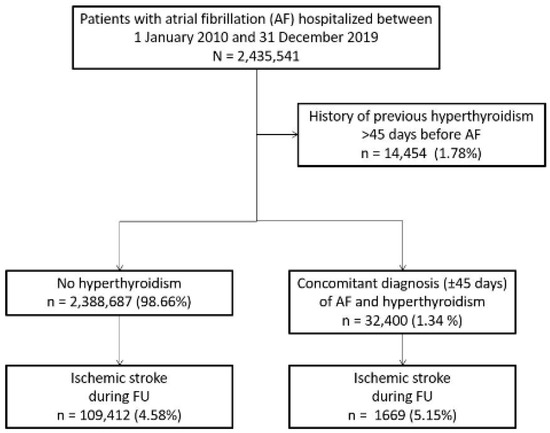
Figure 1.
Flow chart of patients included in the study. FU: follow-up.
The endpoints of ischaemic stroke (ICD code I63), major bleeding and intracranial haemorrhage (ICH) were investigated from January 2010 in the study, and the individual follow-up for each candidate started at the time of first documented AF diagnosis until each specific outcome or the last recorded follow-up in the absence of an outcome. Information on outcomes during follow-up was obtained by analysing the PMSI codes for each patient. Major bleeding was defined as bleeding with new anaemia, or with transfusion of at least 1 unit of blood, or symptomatic bleeding in a critical organ or body area (e.g., intracranial, retroperitoneal, intra-articular, or pericardial) or bleeding that causes death [6].
Statistical Analysis
Qualitative variables were described using counts and percentages, while continuous quantitative variables were described as mean and standard deviation or median and interquartile range. Comparisons were made using parametric or nonparametric tests when appropriate: The Wilcoxon signed rank and Kruskal–Wallis tests were used for comparing values between 2 independent groups, and the χ2 test was used to compare categorical data. Incidence rates (IR) with 95% Confidence Interval (95%CI) were calculated for ischaemic stroke and bleeding events according to the presence of concomitant hyperthyroidism and by multivariable Cox regression models to calculate the relative hazard ratio (HR) and 95%CI for each clinical variable. A proportional hazards model was used to identify independent risk factors associated with the occurrence of each clinical outcome.
Receiver operating characteristic (ROC) curves were constructed, and Harrell C indexes (i.e., area under the curve) were calculated to investigate the predictive value of CHA2DS2VASc and HAS-BLED scores in patients with and without hyperthyroidism; the two curves were compared using the DeLong test.
In all analyses, p < 0.05 was considered statistically significant. Analyses were performed using Enterprise Guide 7.1, (SAS Institute Inc., SAS Campus Drive, Cary, NA, USA), USA and STATA version 16.0 (Stata Corp, College Station, TX, USA).
3. Results
From January 2010 to December 2019, 2,435,541 adults (age ≥ 18 years) were hospitalised with a diagnosis of AF (I48) as the principal diagnosis (i.e., the condition justifying hospital admission), a related diagnosis (i.e., potential chronic disease or health state during the hospital stay), or a significantly associated diagnosis (i.e., comorbidity or associated complication) (Figure 1). This analysis included 2,421,087 AF patients (mean age 77.2 ± 12.1 years; 52.9% women) of which 32,400 (1.3%) had concomitant hyperthyroidism. The interval between the first diagnoses of AF and hyperthyroidism was 1.4 ± 9.5 days (median 0, IQR 00).
Patients with hyperthyroidism had some different characteristics compared to those without, including a higher prevalence of female sex, heart failure and dilated cardiomyopathy (DCM), and lower prevalence of comorbidities, such as coronary artery disease, previous myocardial infarction, vascular disease and cancer (Table 1 and Supplementary Table S1).

Table 1.
Baseline characteristics of patients with AF seen in French hospitals (2010–2019) according to the presence of concomitant hyperthyroidism or not.
3.1. Hyperthyroidism and Ischaemic Stroke
During the follow-up (mean 2.0 ± 2.2 years, median 1.0 IQR 0.1–3.3 years), the accumulative new-onset ischaemic stroke cases were 1669 (Incidence Rate IR: 2.6%/year) in patients with and 30,731 (IR: 2.3%/year) in patients without hyperthyroidism. Figure 2 shows the incidences during the first year of follow-up, and Figure 3 shows the incidences beyond the first year of follow-up. On multivariable Cox regression analysis, the presence of hyperthyroidism (HR 1.133, 95%CI 1.080–1.189, p < 0.0001) was independently associated with ischaemic stroke in the overall cohort (Table 2) This risk was particularly evident within the first year of hyperthyroidism diagnosis (HR 1.203, 95%CI 1.120–1.291), with a nonsignificant association beyond 1 year (HR 1.047, 95%CI 0.980–1.118).
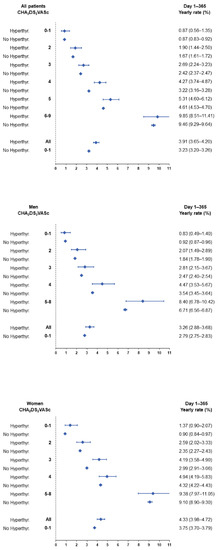
Figure 2.
The yearly incidence of stroke in AF patients stratified by sex, CHA2DS2-VASc score and presence or absence of concomitant hyperthyroidism during the first year of follow-up.
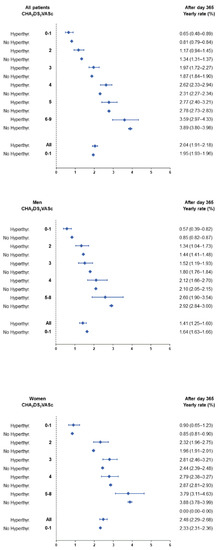
Figure 3.
The yearly incidence of stroke in AF patients stratified by sex, CHA2DS2-VASc score and presence or absence of concomitant hyperthyroidism beyond the first year of follow-up.

Table 2.
Predictors of ischaemic stroke during follow-up in AF patients.
The yearly incidences of stroke in AF patients stratified by sex, the presence or absence of concomitant hyperthyroidism, and the CHA2DS2VASc score are presented in Supplementary Table S3 for the whole follow-up analysis, as well as in Figure 2 for yearly incidences in the first year of follow-up and Figure 3 for yearly incidences after the first year of follow-up, respectively. The incidence of ischaemic stroke was higher in the first year after AF diagnosis than in the subsequent follow-up: yearly incidence 3.24% (95% CI 3.21–3.26) in the first year following the diagnosis of AF vs. 1.95% (95% CI 1.93–1.96) beyond. The overall incidence of ischaemic stroke was higher in patients with hyperthyroidism at baseline and the difference was more marked in women than in men (Supplementary Table S2). The overall risk of ischaemic stroke was 1.20 in HR (95%CI 1.12–1.29) in hyperthyroidism as compared to non-hyperthyroidism in the first year and was significant in both men and women (Supplementary Table S3). Beyond the first year, the risk of ischaemic stroke was slightly lower in male AF patients with hyperthyroidism compared to those without (overall HR 0.86, 95%CI 0.76–0.97), and there was no significant difference in the risk of ischaemic stroke between female patients with and without concomitant hyperthyroidism (overall HR 1.06, 95%CI 0.98–1.15) (Figure 4 and Supplementary Table S3). An increasing CHA2DS2VASc score was consistently associated with a higher incidence of ischaemic stroke during follow-up in both groups of patients with and without hyperthyroidism.
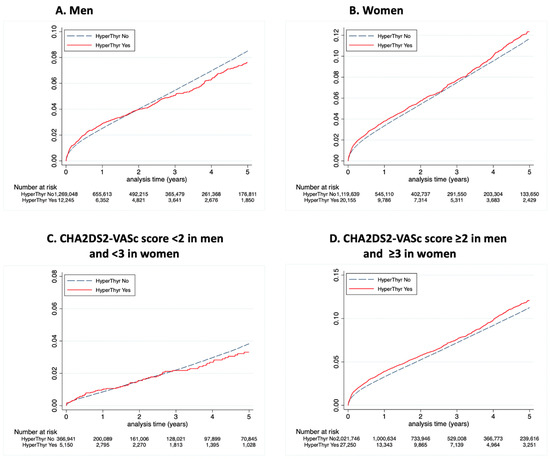
Figure 4.
The cumulative incidence for ischaemic stroke in different sex groups and CHA2DS-VASc score. Cumulative incidences for ischaemic stroke in men (A), women (B), CHA2DS2-VASc score <2 in men and <3 in women (C), and CHA2DS2-VASc score ≥2 in men and ≥3 in women (D) with and without hyperthyroidism concomitant to AF diagnosis (interval <45 days between first diagnoses of AF and hyperthyroidism).
Analysis of ROC curves showed no significant difference in the CHA2DS2-VASc score for the prediction of ischaemic stroke in patients with and without hyperthyroidism: 0.600 (95%CI 0.586–0.613) vs. AUC 0.600 (95%CI 0.597–0.601), respectively (p = 0.94 for DeLong test) (Figure 5).
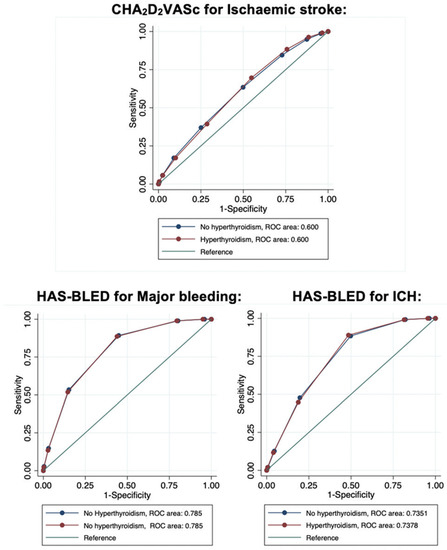
Figure 5.
Receiver Operative Characteristic (ROC) curves in AF patients with and without hyperthyroidism for CHA2DS2-VASc score predicting ischaemic stroke (top panel, p for DeLong test = 0.94) and HAS-BLED score predicting major bleeding (lower left panel, p for DeLong test = 0.99) and intracranial haemorrhage ICH (lower right panel, p for DeLong test = 0.70).
3.2. Hyperthyroidism and Mortality
Compared with ischaemic stroke, no clear differences were observed in the yearly incidences of all-cause mortality and cardiovascular mortality in AF patients with or without concomitant hyperthyroidism, respectively, although a similar trend of significantly higher mortality rates was noted within the first year of hyperthyroidism diagnosis as compared to further beyond (Table 3). Hyperthyroidism was associated with slightly lower all-cause and cardiovascular mortality within the first year in follow-up, and slightly lower risk for all-cause death was noted in AF with concomitant hyperthyroidism over the entire follow-up period; however, no significant association was observed for cardiovascular death during the whole follow-up period (Table 4).

Table 3.
Yearly incidence of all-cause death and cardiovascular death in AF patients according to sex and presence or absence of concomitant hyperthyroidism.

Table 4.
Hazard ratios for the association between hyperthyroidism and all-cause mortality and cardiovascular mortality during (1) whole follow-up, (2) the first year of follow-up after concomitant diagnoses of AF and hyperthyroidism, and (3) beyond the first year of follow-up.
3.3. Bleeding Events and HAS-BLED Score
AF patients with concomitant hyperthyroidism had a lower incidence of major bleeding (n = 3085, IR 5.1%/year) compared to those without (n = 238,565, IR 5.4%/year, p < 0.0001). Analysis of ROC curves for HAS-BLED score predicting major bleeding in patients with and without hyperthyroidism showed that the predictive performance was good with an AUC 0.785 (95%CI 0.784–0.786) in patients without hyperthyroidism, and AUC 0.785 (95%CI 0.777–0.792) in patients with a history of hyperthyroidism (DeLong test, p = 0.99) (Figure 5).
Regarding ICH, patients with hyperthyroidism had a similar incidence of ICH (n = 777, IR 1.2%/year) compared to those without (n = 56,305, IR 1.2%/year, p = 0.80). Analysis of ROC curves for HAS-BLED score predicting ICH in patients with and without hyperthyroidism also showed that the predictive performance was good with an AUC 0.735 (95%CI 0.733–0.737) in patients without hyperthyroidism, and AUC 0.738 (95%CI 0.724–0.752) in patients with a history of hyperthyroidism (DeLong test, p = 0.70) (Figure 5).
4. Discussion
This is the largest published analysis using a national discharge database on the yearly incidence of stroke and bleeding in hospitalised AF patients with and without concomitant hyperthyroidism. It noted an increased incidence of ischaemic stroke in hospitalised AF patients with hyperthyroidism compared to those without, and the highest incidence was noted in the first year following the diagnosis of hyperthyroidism. Beyond the first year in follow-up, the risk of ischaemic stroke among all the AF patients with hyperthyroidism was not statistically different than in those without. The CHA2DS2-VASc score and HAS-BLED scores performed similarly well in patients with AF with and without hyperthyroidism for predicting ischaemic stroke and major bleeding. Thus, the HAS-BLED score is the only bleeding risk score tested in patients with AF and hyperthyroidism.
Compared with other hospital-based cohort studies [7,8], the current study is based on a “real-world” discharge dataset at a much larger scale. There were some differences in the demographics and cardiovascular risk profiles in the hyperthyroid AF patients as compared to non-thyroid AF patients in the current study. The baseline characteristics in the current study resemble that of Bruere et al. [8], although a higher CHA2DS2-VASc score (mean: 3.6 vs. 3.1), and lower previous ischaemic stroke rate (6% vs. 9%) were noted in the current cohort compared with theirs. A lower yearly incidence of ischaemic stroke was noted in the current study in comparison with the cohort of Chen et al. (2.6% vs. 7.6% in hyperthyroid AF, 2.3% vs. 3.6% in non-thyroid AF) [7]. The difference in stroke incidence could be due to younger subjects in whom hyperthyroidism might be a more prominent risk factor in an otherwise lower risk population for ischaemic stroke [9], as well as the possible difference in the prescription rate of oral anticoagulation between the studies. A Mendelian randomization study using genome-based data reported a causal association between TSH levels and free thyroxine and stroke, mainly mediated via AF [10]. The higher risk of stroke associated with hyperthyroidism was mainly seen in patients with intermediate risk (e.g., CHA2DS2-VASc score 4 group). There is no clear explanation for this finding, but one might suggest that the higher risk of stroke with hyperthyroidism may not be clinically significant when the intrinsic risk of stroke is low, whereas this effect is mitigated by other risk factors when the risk of stroke is high.
The finding of highest ischaemic stroke incidence within the first year of diagnosis of hyperthyroidism in the AF population was similar to a Danish population-based cohort where the highest risk for ischaemic stroke (adjusted HR: 2.70, 95%CI: 2.31–3.14) was in the first 3 months following the diagnosis of hyperthyroidism in a general population for whom the prevalence of AF at baseline was not reported [11]. Similarly, a recent Korean national database-derived study also identified an increased risk of thromboembolism within the first year of a hyperthyroidism-related AF diagnosis [12]. In another cohort which included 160 patients with hyperthyroidism-induced AF, the majority of ischaemic strokes occurred within the first 30 days of initial presentation of AF (73% vs. 80% in hyperthyroid AF vs. non-thyroid AF) [13]. Hyperthyroidism causes a proinflammatory, procoagulant state in acute phases [14], arterial remodelling, stiffness and atherosclerosis over longer terms [15]. The acute prothrombotic phase immediately following the diagnosis of hyperthyroidism might be a treatment window to prevent thromboembolism and other cardiovascular events [16,17]. The finding of the current study suggests the importance of prompt risk stratification for stroke and initiation of oral anticoagulation following the diagnosis of hyperthyroidism [18], as well as timely treatment of hyperthyroidism to prevent stroke [19]. Beyond the higher risk of ischaemic stroke in the first months, current results also contradict the idea that the risk of ischaemic stroke would be markedly lower (and OAC not needed) in patients with transient AF once hyperthyroidism has been appropriately managed, confirming results from smaller reports about AF and a presumed “temporary cause” [20].
Two recent retrospective nationwide database-derived studies using propensity score-matched analyses in the developed region in Asia had contradictory findings in the risk of thromboembolism associated with hyperthyroid AF [12,21]. Cautious interpretation of these findings, while acknowledging the inherent limitations and bias of retrospective analysis of coded information is advised. Further large-scale prospective matched-cohort studies which investigate and characterize both the short-term and the long-term stroke events of new-onset hyperthyroidism in AF patients would be desirable. Prospective trials investigating the effectiveness and feasibility of a clinical algorithm that promotes timely and accurate stroke risk assessment, initiation of OAC, and hyperthyroidism treatment for concomitant hyperthyroidism in AF patients with varying thromboembolic risk profiles could provide further guidance to clinical practice.
Limitations
Due to its observational design using a discharge database with ICD coding for diagnosis, there was a lack of ascertainment of individual cases. There is a lack of information over the coherence of the hyperthyroidism diagnosis, as well as the clinical course of the condition. Abnormal thyroid function tests were not uncommon among patients with recent onset of AF; however, overt hyperthyroidism is rather uncommon over medium terms follow-up [22], thereby, subclinical or undiagnosed hyperthyroidism could have contributed to AF unnoticeably in a proportion of the cohort. The study adopted the cut-off interval as within 45 days between the first diagnosis of hyperthyroidism and AF for inclusion, however, some patients included in the cohort could have been affected by subclinical or undiagnosed hyperthyroidism for a more extended period before the inclusion. This limitation could potentially affect the interpretation of the relationship between the hyperthyroidism diagnosis and the observed clinical outcomes. Additionally, given the information on the initiation and efficacy of antithyroid treatment were also lacking, it is uncertain whether hyperthyroidism treatment could have reduced the difference in stroke incidence between the two groups beyond the first year of diagnosis. Given that the current study only included patients hospitalised with AF, patients with presumably milder symptoms or asymptomatic with AF could be missed from the study, possible selection bias exists and needs to be taken into consideration during the interpretation and extrapolation of the findings.
Another limitation of the study is its lack of information on the prescription, particularly concerning the initiation, duration, and effectiveness of the oral anticoagulation in the national database investigated. The delayed prescription and suboptimal dosing and adherence to anticoagulation could be a potentially important confounding factor for the increased stroke events observed within the first year of hyperthyroidism diagnosis. Furthermore, results may be different with direct oral anticoagulants that are associated with improved survival compared to vitamin K antagonists in patients with AF, irrespective of concomitant hyperthyroidism [18,23].
There is a major limitation in the evaluation process for the independent risk factors of ischaemic stroke due to its design using two unmatched cohorts from an ICD-coded database. Despite adopting multivariate Cox regression which incorporated all the clinical risk factors identified and accessible in the database in the risk factor analysis, the lack of direct information on the prescription and treatment efficacy of oral anticoagulation, the potential underdiagnosis and undertreatment of subclinical thyroid disorder, etc., could potentially introduce confounding bias and compromise the association between hyperthyroidism and ischaemic stroke.
The generalization of our findings to other populations and regions might also be limited given different ethnic compositions, level of healthcare service and prevalence of the relevant diseases and risk factors.
5. Conclusions
In this nationwide atrial fibrillation study, the highest incidence of ischaemic stroke was noted in hospitalised AF patients within the first year of hyperthyroidism diagnosis, during which period hyperthyroidism seemed to be an independent risk factor of ischaemic stroke. Beyond the timeframe, however, there was no independent contribution of hyperthyroidism to ischaemic stroke in hospitalised AF patients. No significant difference was noted between hospitalised AF patients with or without concomitant hyperthyroidism in the yearly incidence of all-cause mortality and cardiovascular mortality, respectively. Hospitalised AF patients with concomitant hyperthyroidism were noted with a lower incidence of major bleeding and similar incidence of ICH as compared to those without.
Supplementary Materials
The following supporting information can be downloaded at: https://www.mdpi.com/article/10.3390/jcm11051342/s1, Table S1: Baseline characteristics of AF patients admitted to French hospitals (2010–2019) according to the presence and absence of concomitant hyperthyroidism in men (1a) and women (1b), respectively; Table S2: Yearly incidence of stroke in AF patients stratified by sex, presence or absence of concomitant hyperthyroidism and the CHA2DS2VASc score; Table S3: Hazard ratios for the association between hyperthyroidism and ischaemic stroke during (1) whole follow-up, (2) first year of follow-up after concomitant diagnoses of AF and hyperthyroidism, and (3) beyond the first year of follow-up.
Author Contributions
J.Z.: drafting of the manuscript; A.B. (Arnaud Bisson): interpretation of the results and critical revision of the manuscript.; G.F.: interpretation of the results and critical revision of the manuscript; A.B. (Alexandre Bodin): interpretation of the results and critical revision of the manuscript.; J.H.: developed the database; P.H.D.: interpretation of the results and critical revision of the manuscript; G.Y.H.L.: design of the study, interpretation of the results and critical revision of the manuscript; L.F.: conceived the study, developed the database, performed the statistical analysis and drafted the manuscript; G.Y.H.L. is the guarantor of the study. G.Y.H.L. accepts full responsibility for the work and/or the conduct of the study, had access to the data, and controlled the decision to publish. He attests that all listed authors meet authorship criteria and that no others meeting the criteria have been omitted. All authors have read and agreed to the published version of the manuscript.
Funding
This research received no external funding.
Data Availability Statement
This study used data from human subjects, the data and everything pertaining to the data are governed by the French Health Agencies thereby cannot be made available to other researchers.
Conflicts of Interest
Gregory YH Lip: Consultant and speaker for BMS/Pfizer, Boehringer Ingelheim and Daiichi-Sankyo. No fees are received personally. Laurent Fauchier: reports personal fees from Bayer, personal fees from BMS Pfizer, personal fees from Boehringer Ingelheim, personal fees from Medtronic, personal fees from Novartis, outside the submitted work. Other authors have no conflicts of interest to disclose.
References
- Flynn, R.W.V.; MacDonald, T.; Morris, A.D.; Jung, R.T.; Leese, G.P. The Thyroid Epidemiology, Audit, and Research Study: Thyroid Dysfunction in the General Population. J. Clin. Endocrinol. Metab. 2004, 89, 3879–3884. [Google Scholar] [CrossRef] [PubMed]
- Petersen, P.; Hansen, J.M. Stroke in thyrotoxicosis with atrial fibrillation. Stroke 1988, 19, 15–18. [Google Scholar] [CrossRef] [PubMed] [Green Version]
- Selmer, C.; Olesen, J.B.; Hansen, M.L.; Lindhardsen, J.; Olsen, A.-M.S.; Madsen, J.C.; Faber, J.; Hansen, P.R.; Pedersen, O.D.; Torp-Pedersen, C.; et al. The spectrum of thyroid disease and risk of new onset atrial fibrillation: A large population cohort study. BMJ 2012, 345, e7895. [Google Scholar] [CrossRef] [PubMed] [Green Version]
- Selmer, C.; Hansen, M.L.; Olesen, J.B.; Mérie, C.; Lindhardsen, J.; Olsen, A.-M.S.; Madsen, J.C.; Schmidt, U.; Faber, J.; Hansen, P.R.; et al. New-Onset Atrial Fibrillation Is a Predictor of Subsequent Hyperthyroidism: A Nationwide Cohort Study. PLoS ONE 2013, 8, e57893. [Google Scholar] [CrossRef] [Green Version]
- Sohn, S.Y.; Lee, E.; Lee, M.K.; Lee, J.H. The Association of Overt and Subclinical Hyperthyroidism with the Risk of Cardiovascular Events and Cardiovascular Mortality: Meta-Analysis and Systematic Review of Cohort Studies. Endocrinol. Metab. 2020, 35, 786–800. [Google Scholar] [CrossRef]
- Cutlip, D.E.; Windecker, S.; Mehran, R.; Boam, A.; Cohen, D.J.; van Es, G.-A.; Steg, P.G.; Morel, M.-A.; Mauri, L.; Vrancks, P.; et al. Clinical end points in coronary stent trials: A case for standardized definitions. Circulation 2007, 115, 2344–2351. [Google Scholar] [CrossRef] [Green Version]
- Chen, Q.; Yan, Y.; Zhang, L.; Cheng, K.; Liu, Y.; Zhu, W. Effect of Hyperthyroidism on the Hypercoagulable State and Thromboembolic Events in Patients with Atrial Fibrillation. Cardiology 2014, 127, 176–182. [Google Scholar] [CrossRef]
- Bruere, H.; Fauchier, L.; Brunet, A.B.; Pierre, B.; Simeon, E.; Babuty, D.; Clementy, N. History of Thyroid Disorders in Relation to Clinical Outcomes in Atrial Fibrillation. Am. J. Med. 2015, 128, 30–37. [Google Scholar] [CrossRef]
- Sheu, J.J.; Kang, J.-H.; Lin, H.-C.; Lin, H.-C. Hyperthyroidism and risk of ischemic stroke in young adults: A 5-year follow-up study. Stroke 2010, 41, 961–966. [Google Scholar] [CrossRef] [Green Version]
- Marouli, E.; Kus, A.; Del Greco, M.F.; Chaker, L.; Peeters, R.; Teumer, A.; Deloukas, P.; Medici, M. Thyroid Function Affects the Risk of Stroke via Atrial Fibrillation: A Mendelian Randomization Study. J. Clin. Endocrinol. Metab. 2020, 105, 2634–2641. [Google Scholar] [CrossRef]
- Dekkers, O.M.; Horváth-Puhó, E.; Cannegieter, S.C.; Vandenbroucke, J.P.; Sørensen, H.T.; Jørgensen, J.O.L. Acute cardiovascular events and all-cause mortality in patients with hyperthyroidism: A population-based cohort study. Eur. J. Endocrinol. 2017, 176, 1–9. [Google Scholar] [CrossRef] [PubMed] [Green Version]
- Kim, K.; Yang, P.-S.; Jang, E.; Yu, H.T.; Kim, T.-H.; Uhm, J.-S.; Kim, J.-Y.; Sung, J.-H.; Pak, H.-N.; Lee, M.-H.; et al. Increased risk of ischemic stroke and systemic embolism in hyperthyroidism-related atrial fibrillation: A nationwide cohort study. Am. Hear. J. 2021, 242, 123–131. [Google Scholar] [CrossRef] [PubMed]
- Siu, C.-W.; Pong, V.; Zhang, X.; Chan, Y.-H.; Jim, M.-H.; Liu, S.; Yiu, K.-H.; Kung, A.W.; Lau, C.-P.; Tse, H.-F. Risk of ischemic stroke after new-onset atrial fibrillation in patients with hyperthyroidism. Hear. Rhythm 2009, 6, 169–173. [Google Scholar] [CrossRef] [PubMed]
- Elbers, L.P.B.; Moran, C.; Gerdes, V.E.; van Zaane, B.; Meijers, J.; Endert, E.; Lyons, G.; Chatterjee, V.K.; Bisschop, P.H.; Fliers, E. The Hypercoagulable state in Hyperthyroidism is mediated via the Thyroid Hormone beta Receptor pathway. Eur. J. Endocrinol. 2016, 174, 755–762. [Google Scholar] [CrossRef] [PubMed] [Green Version]
- Yildiz, C.; Altay, M.; Yildiz, S.; Çağir, Y.; Akkan, T.; Ünsal, Y.A.; Beyan, E. Arterial stiffness in hyperthyroid patients is deteriorated due to thyroid hormones. Arch. Endocrinol. Metab. 2019, 63, 258–264. [Google Scholar] [CrossRef]
- Tsai, M.-S.; Chuang, P.-Y.; Shih, S.-R.; Chang, W.-T.; Chen, N.-C.; Yu, P.-H.; Cheng, H.-J.; Tang, C.-H.; Chen, W.-J. Better adherence to antithyroid drug is associated with decreased risk of stroke in hyperthyroidism patients. Int. J. Clin. Practic. 2015, 69, 1473–1485. [Google Scholar] [CrossRef]
- Lillevang-Johansen, M.; Abrahamsen, B.; Jørgensen, H.L.; Brix, T.H.; Hegedüs, L. Duration of Hyperthyroidism and Lack of Sufficient Treatment Are Associated with Increased Cardiovascular Risk. Thyroid 2019, 29, 332–340. [Google Scholar] [CrossRef]
- Chan, Y.-H.; Wu, L.-S.; See, L.-C.; Liu, J.-R.; Chang, S.-H.; Chao, T.-F.; Yeh, Y.-H.; Kuo, C.-T.; Lee, H.-F.; Lip, G.Y.H. Direct Oral Anticoagulants in Atrial Fibrillation Patients With Concomitant Hyperthyroidism. J. Clin. Endocrinol. Metab. 2020, 105, 2893–2904. [Google Scholar] [CrossRef]
- E Okosieme, O.; Taylor, P.N.; Evans, C.; Thayer, D.; Chai, A.; Khan, I.; Draman, M.S.; Tennant, B.; Geen, J.; Sayers, A.; et al. Primary therapy of Graves’ disease and cardiovascular morbidity and mortality: A linked-record cohort study. Lancet Diabetes Endocrinol. 2019, 7, 278–287. [Google Scholar] [CrossRef]
- Fauchier, L.; Clementy, N.; Bisson, A.; Stamboul, K.; Ivanes, F.; Angoulvant, D.; Babuty, D.; Lip, G.Y.H. Prognosis in patients with atrial fibrillation and a presumed “temporary cause” in a community-based cohort study. Clin. Res. Cardiol. 2016, 106, 202–210. [Google Scholar] [CrossRef]
- Lin, Y.-S.; Tsai, H.-Y.; Lin, C.-Y.; Wu, V.C.-C.; Chen, T.-H.; Yang, T.-Y.; Aboyans, V.; Chen, M.-C. Risk of Thromboembolism in Non-Valvular Atrial Fibrillation With or Without Clinical Hyperthyroidism. Glob. Hear. 2021, 16, 45. [Google Scholar] [CrossRef] [PubMed]
- Krahn, A.D.; Klein, G.J.; Kerr, C.R.; Boone, J.; Sheldon, R.; Green, M.; Talajic, M.; Wang, X.; Connolly, S. How useful is thyroid function testing in patients with recent-onset atrial fibrillation? The Canadian Registry of Atrial Fibrillation Investigators. Arch. Intern. Med. 1996, 156, 2221–2224. [Google Scholar] [CrossRef] [PubMed]
- Goldstein, S.A.; Green, J.; Huber, K.; Wojdyla, D.M.; Lopes, R.D.; Alexander, J.H.; Vinereanu, D.; Wallentin, L.; Granger, C.B.; Al-Khatib, S.M. Characteristics and Outcomes of Atrial Fibrillation in Patients with Thyroid Disease (from the Aristotle Trial). Am. J. Cardiol. 2019, 124, 1406–1412. [Google Scholar] [CrossRef] [PubMed]
Publisher’s Note: MDPI stays neutral with regard to jurisdictional claims in published maps and institutional affiliations. |
© 2022 by the authors. Licensee MDPI, Basel, Switzerland. This article is an open access article distributed under the terms and conditions of the Creative Commons Attribution (CC BY) license (https://creativecommons.org/licenses/by/4.0/).